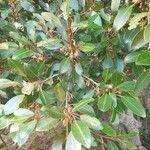Small to medium tree (rarely a shrub), height up to 20 m., with much branched dense evergreen crown; bark grey or blackish, rough.. Young branches and petioles with ferrugineous pubescence, later wearing away.. Petioles 1–3 cm. long.. Leaf-lamina thinly coriaceous to coriaceous, ± elliptic, obovate-elliptic to ± oblanceolate, (4-)5–9(–11) cm. long, (l.7-)2.3–4(–4.5) cm. wide, obtuse to ± broadly acute or rarely shortly acuminate, broadly cuneate; upper surface dark green and glossy, with slightly raised nervation, lower surface paler, practically glabrous except on and near midrib; lateral nerves ascending, finely raised.. Flowers usually 2–3 per axil; pedicels l.5–2.5(–3.5) cm. long, curved, with dense ferrugineous or brownish pubescence.. Outer sepals ± lanceolate, up to 11 mm. long, 4 mm. wide, externally with dense ferrugineous or brownish pubescence.. Corolla-lobes cream or whitish, trifid; segments linear-lanceolate, up to 9.5 mm. long; tube up to 2 mm. long.. Filaments up to 3 mm. long.. Staminodes narrowly lanceolate, up to 5 mm. long, narrowly acute, simple or sometimes minutely laciniate.. Ovary up to 2.5 mm. long, densely pilose; style tapering, up to 1 cm. long.. Mature fruit an orange or yellowish ± ellipsoid or ovoid-subglobose berry, 1.5–3.5 cm. long and 1.5–2.5 cm. in diameter, with firm tough skin.. Seeds 1–2 (very rarely more), variable in shape, generally ± ellipsoid or sometimes ± oblong when more than one seed present, l–2(–2.5) cm. long, up to 1.2 cm. wide and 6 mm. thick; testa shiny pale brown, hard and horny; hilum ± basal in small circular depression.
An evergreen tree. It often grows 4.5-6 m tall but can be 15 m tall. It has spreading branches. Young plant parts have reddish hairs. The leaves are simple and alternate. They are leathery and dark green above and duller underneath. Leaves are 3.5-11 cm long by 2-5 cm wide. The leaf stalks are reddish and 2.5 cm long. The young leaves are a rusty velvet below. The flowers are white. They have a sweet smell. They occur in clusters on long, curved, hairy red stalks. The fruit are round berries 2-3 cm long. When young they are green with white dots and when mature are bright yellow. There are one or more shiny brown seeds inside. The fruit are edible.
Leaf–lamina 3·5–11·5 x 1·4–5·5 cm., elliptic, oblong–elliptic, obovate–elliptic or lanceolate; apex tapering or acute or rounded and slightly emarginate, but most often bluntly apiculate; base acute to acuminate; petiole 0·6–3·5 cm. long. Upper leaf surface glossy, usually with prominent midrib and vein reticulation but sometimes the latter obscured beneath the thick leathery cuticle, initially or soon becoming completely glabrous. Lower surface mat, with prominent midrib and fairly conspicuous reticulation, more tardily glabrescent than above, indumentum sometimes becoming grey, sometimes persisting along midrib.
Tree, up to 15 m high. Leaves often longer than 60 mm, petioles longer than 10 mm, young leaves and tips of young branches densely rusty-pubescent. Flowers up to 15 mm in diameter when fully expanded, often in clusters of more than 2 flowers; dull white, pale cream or pale yellow.
Evergreen shrub branching near the ground to tall tree with long clean trunk, 2–23 m. tall; slash white, pink or crimson; bark grey to black, smooth or shallowly grooved or roughly reticulately fissured; buttresses absent; crown (in larger specimens) wide–spreading, rounded.
Corolla equalling or slightly longer or shorter than calyx, white to pale brownish–yellow; lateral segments narrowly triangular or lanceolate, median segment equalling, longer or shorter than laterals, elliptic with narrow basal attachment; tube 1–2 mm. long.
Fruit up to 4·5 cm. long, edible, plum–shaped, 1–seeded, with brittle yellow or orange epicarp and floury astringent orange pulp; fruiting calyx cupped round fruit or spreading.
Young stems and leaves often densely ferrugineous appressed–pubescent, glabrescent, older twigs with longitudinally wrinkled grey bark.
Flowers sweetly scented, borne in axillary fascicles of 1–7; pedicels 10–17 mm., but elongating in fruit.
Staminodes half as long as to almost equalling corolla, shorter or longer than stamens.
Gynoecium 6·5–9 mm. long.
Anthers 2·5–3·5 mm. long.
Calyx 6·5–9·5 mm. long.
Seed c. 1·8 mm. long.


